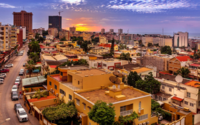Portal:Kylaris/Features: Difference between revisions
No edit summary |
Tag: Undo |
||
| Line 1: | Line 1: | ||
<div style="float:left;margin:0.5em 0.9em 0.4em 0;">[[File:Centro_SP2.jpg| | <div style="float:left;margin:0.5em 0.9em 0.4em 0;">[[File:Centro_SP2.jpg|200px]]</div> '''Castelonovo''' ({{wp|Help:IPA/Portuguese|[''kɐstʃelɔnovo'']}}), officially the '''Municipality and Federal Capital of Castelonovo''' ({{wp|Portuguese language|Iustian}}: ''Município e Capital Federal de Castelonovo''), is the capital and largest city of [[Belmonte]]. According to the last demographic census made in 2018, the general population of the city and its metropolitan area corresponds to 3,724,976 inhabitants. | ||
Founded by {{wp|bandeirantes}} in the 16th century, Castelonovo was located between several trade routes that transported goods to villages and markets, which made the small city become within a few years an important commercial centre to the colony. Also, the rough terrain was frequently used as a natural barrier against indigenous attacks, which was another decisive factor for the upcoming centralization and transference of various public services and institutions that were formerly situated in several coastal cities to there. Soon after the [[Asterian War of Secession|Belmontese independence]], the city already was the most important of the entire country, but it only became the national capital and its own province after the establishment of the [[History of Belmonte|republic]] in 1819. ('''[[Castelonovo|See more...]]''') | |||
<hr> | <hr> | ||
<div style="float:left;margin:0.5em 0.9em 0.4em 0;">[[File:Mambiza_pic.PNG| | <div style="float:left;margin:0.5em 0.9em 0.4em 0;">[[File:Mambiza_pic.PNG|200px]]</div> '''Mambiza''' ({{wp|Help:IPA/English|/'mæmbi:za/}}; officially '''Sainte-Germaine''' until 1970) is the largest city in [[Garambura]]. The city has one of the largest designated metropolitan areas in Garambura, at 1,253.9km<sup>2</sup> (481.4mi<sup>2</sup>), and an urban population of 4,489,140 in 2014, with a total population of just over 4.5 million inhabitants. Mambiza itself is a metropolitan province of Garambura, and is represented by its elected governor Rupenyu Majange. The city sits on the expansive Gonda Delta and its coastal location makes it a popular destination for global trade. | ||
The city was founded as a trading outpost in 1656 by [[Gaullica|Gaullican]] merchants, who named the city ''Sainte-Germaine'' after the [[Solarian Catholic Church|Sotirian]] venerated figure. It served as a stopover for trade between [[Euclea]] and southern [[Coius]], namely [[Xiaodong]] and [[Senria]], and so the city's wealth grew under the Gaullicans. It was designated as the capital of [[Baséland]] when it fell under full Gaullican sovereignty in 1813, and was designated a city in 1814. Mambiza was the site of [[Charles Dumont]]'s famous ''Droits de l'homme'' speech in 1919, before he was executed in the city by national functionalists. Many of the city's inhabitants were conscripted during the [[Great War (Kylaris)|Great War]]. ('''[[Mambiza|See more...]]''') | |||
<div style="text-align:right>[[File:KylarisRecognitionAchievement.png|25px]] '''{{cl|Kylaris Articles of Recognition|See all articles of recognition}}'''</div> | <div style="text-align:right>[[File:KylarisRecognitionAchievement.png|25px]] '''{{cl|Kylaris Articles of Recognition|See all articles of recognition}}'''</div> | ||
Revision as of 23:48, 31 August 2020
Castelonovo ([kɐstʃelɔnovo]), officially the Municipality and Federal Capital of Castelonovo (Iustian: Município e Capital Federal de Castelonovo), is the capital and largest city of Belmonte. According to the last demographic census made in 2018, the general population of the city and its metropolitan area corresponds to 3,724,976 inhabitants.
Founded by bandeirantes in the 16th century, Castelonovo was located between several trade routes that transported goods to villages and markets, which made the small city become within a few years an important commercial centre to the colony. Also, the rough terrain was frequently used as a natural barrier against indigenous attacks, which was another decisive factor for the upcoming centralization and transference of various public services and institutions that were formerly situated in several coastal cities to there. Soon after the Belmontese independence, the city already was the most important of the entire country, but it only became the national capital and its own province after the establishment of the republic in 1819. (See more...)
Mambiza (/'mæmbi:za/; officially Sainte-Germaine until 1970) is the largest city in Garambura. The city has one of the largest designated metropolitan areas in Garambura, at 1,253.9km2 (481.4mi2), and an urban population of 4,489,140 in 2014, with a total population of just over 4.5 million inhabitants. Mambiza itself is a metropolitan province of Garambura, and is represented by its elected governor Rupenyu Majange. The city sits on the expansive Gonda Delta and its coastal location makes it a popular destination for global trade.
The city was founded as a trading outpost in 1656 by Gaullican merchants, who named the city Sainte-Germaine after the Sotirian venerated figure. It served as a stopover for trade between Euclea and southern Coius, namely Xiaodong and Senria, and so the city's wealth grew under the Gaullicans. It was designated as the capital of Baséland when it fell under full Gaullican sovereignty in 1813, and was designated a city in 1814. Mambiza was the site of Charles Dumont's famous Droits de l'homme speech in 1919, before he was executed in the city by national functionalists. Many of the city's inhabitants were conscripted during the Great War. (See more...)

